Monarch butterfly release events celebrate lives of loved ones
Administrator | Sep 18, 2017 | Comments 3
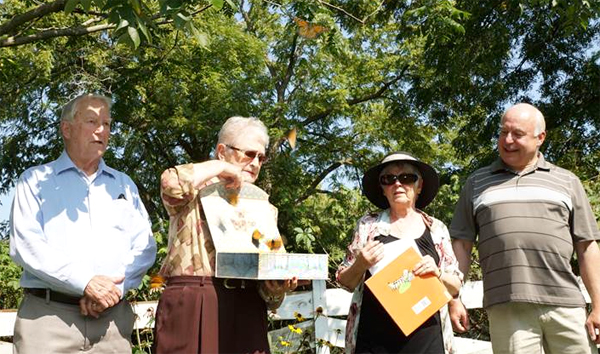
Leo and Maureen Finnegan release their butterflies at the Whattam Funeral Home park while hospital foundation vice-chairman Fran Donaldson and Whattam and Hicks funeral homes owner Bob Osborne look on. – Sandra Foreman photo
By Sharon Harrison
Two hundred monarch butterflies were released Sunday in open-air celebrations of the lives and memories of loved ones.
The Prince Edward County Memorial Hospital Foundation’s inaugural ‘Celebration of Life Monarch Butterfly Release’ was held simultaneously at Wellington Park and at the Whattam Funeral Home garden in Picton on a warm and still late summer afternoon.
“Butterflies are an acknowledgement of a life lived,” said Monica Alyea, hospital foundation chairman. “Their release signifies freedom and encourages those left behind to take another step in the healing process.”
“For many people, butterflies are nature’s moving paintings, so symbolic of lazy, warm summer days. For others, they represent endurance, change, hope and life,” said Briar Boyce, the hospital foundation’s communications co-ordinator. “Though they are as delicate as lace, they have the strength to undertake an incredible journey from their summer homes to locations in California and Mexico, some as long as 4,800 kilometres, where millions of them winter.”
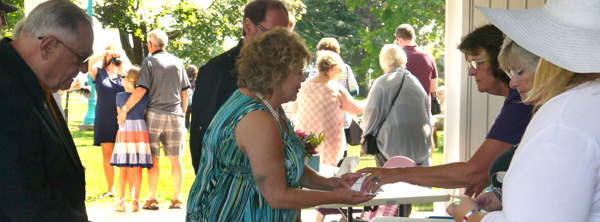
Prince Edward County Memorial Hospital Foundation members handed out the butterflies from the gazebo in Wellington. – Sharon Harrison photo
The monarch butterflies were released by participants at a moment chosen by them in a quiet corner, under a big shade tree or simply in the open sunshine.
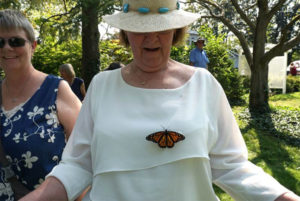
A monarch poses as a most beautiful brooch before taking off into the sunshine at the PECMHF release at the Whattam Funeral Home park in Picton. – Sandra Foreman photo
Boyce informed participants the butterflies were kept comfortable in a hibernation state and would need a little encouragement to take flight.
People were encouraged to hold the boxed butterflies in their hands for a few minutes where the natural heat and the bright light would help awaken and energize them, inspiring them to take flight.
Dealing with the loss of a loved one is often a difficult time for families and friends, said Boyce, noting everyone deals with grief differently.
“Each spring brings new monarchs back to our region. That’s why this incredible cycle of life so perfectly represents our own human expression of our connections with the life and memory of our loved ones.”
Catharine Huff was accompanied by husband Lanny and at least six family members, two of whom had travelled from Ottawa. They released six butterflies each representing the memory of a family member who had passed away in recent years. Huff said it was “a very meaningful event to have at this time of year”, adding, “she was happy to do anything to support the hospital.”
Wendy Davis, of Wellington, released a butterfly in remembrance of her son’s girlfriend Melissa Coghlan, as well as her stepfather and brother-in-law. The significance of the butterfly is important to Davis, who proudly displays a butterfly tattoo on her ankle.
Accompanying Davis was Ruth Mace whose butterfly release was in memory of her daughter Wendy who passed away battling cancer, in January 2016, at age 54. Davis and Mace said the afternoon was a lovely and special occasion which meant a lot to them.
Tod Lavender, of Ainsworth Funeral Home in Wellington, partnered with the Foundation, along with Bob Osborne, of the Whattam and Hicks funeral homes in Picton, for the unique remembrance memorial.
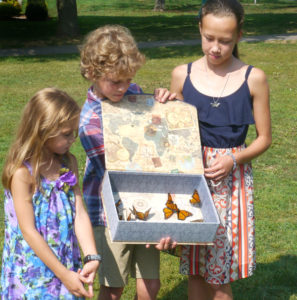
Vanessa, 12, Theo, 10, and Claire, age six, carefully opened their box and patiently held it still as the butterflies slowly emerged and one-by-one, flew away. – Sharon Harrison photo
“Not only is it a great way to recognize and support our County hospital, but it is an opportunity to honour the memory of those who have passed, in a special and meaningful way,” said Lavender.
“The idea of a butterfly release stemmed from a conversation between myself and Marion Smith, a long-time donor and friend of the foundation,” said Boyce. “I asked Smith what the most memorable event she ever attended was and the answer came quickly and simply – a butterfly release.”
The foundation’s event also included a mass release for remaining butterflies not specifically spoken for, and for those who were not able to attend but requested the release of butterflies for them.
Vanessa, 12, Theo, 10, and Claire, age six, carefully opened the box’s lid and patiently held it still as the butterflies slowly emerged. With a little encouragement from the children, the butterflies, one-by-one, flew away.
“Not only do we need more monarch butterflies in our lives, but from this day forward, whenever you see one of these beautiful creatures, you’ll be touched once again by the memory of this day, and of your loved one,” said Boyce.
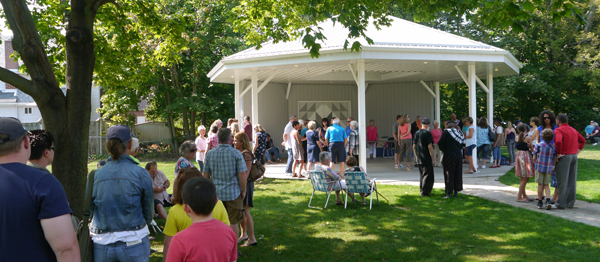
Participants gathered for the Prince Edward County Memorial Hospital Foundation’s inaugural Celebration of Life Monarch Butterfly release in Wellington Park. – Sharon Harrison photo
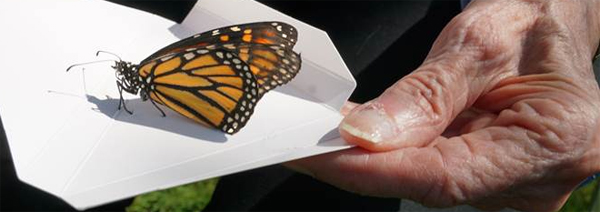
Participants held the boxed butterflies in their hands for a few minutes where the natural heat and the bright light would help awaken and energize them, inspiring them to take flight. – Sandra Foreman photo
Filed Under: Featured Articles • Local News
About the Author:

































Hospital Foundation responds – more on releasing monarchs.
Life is full of possibilities and so is the article “Live butterfly release trend worrying” from The County Weekly News edition of Sept 21.
Mr. Glassberg is quoted as writing “it is possible that their (commercially raised monarchs) delicate migratory physiology may not have been turned on.” He is also quoted as stating that “Butterflies raised by unregulated commercial interests may spread diseases and parasites to wild populations”
If you read the North American Butterfly Association (NABA) article in its entirety, it becomes clear that five authors who penned the article have strong opinions, but little is offered in the way of scientific evidence to support these opinions.
Sheri Moreau, Board of Directors of the Monarch Program and International Butterfly Breeders Association (IBBA) and Director of The Butterfly Conservancy responds in her post Butterfly Releases Unjustly Maligned. She quotes years of monarch research in her rebuttal of the NABA post.
Mr Glassberg invites you to “imagine tens of thousands of mixed-up monarchs unable to find the way to their overwintering grounds.” Monarch migrate using the sun, as has been revealed in many studies. Ms. Moreau quotes Robert Gendron, a Cal-Poly student with over five years of experience in monarch tagging research.
“ . . fifth generation captive-bred monarchs released in the San Francisco Bay Area were subsequently spotted in four overwintering sites from Santa Cruz to Pacific Grove. Dozens of tagged eastern monarchs, hand-reared in classrooms by school children, have been released across Canada and North America and been recovered at Mexican overwintering sites. While some of these monarchs were raised from wild-caught larvae, several thousand of them were from larvae sold in educational kits by the University of Kansas. Certainly the migratory mechanism was fully functional in these butterflies, reared hundreds, even thousands of miles from their natal origin.”
Ms. Moreau also addressed the issue of commercially raised monarchs spreading disease.
“Commercial breeders who do not maintain pathogen-free breeding conditions are out of business in a season or less. Predators, parasites and pathogens have far more impact on wild butterfly populations, where there less than 2% of all eggs laid mature into adult butterflies. . . wild butterfly . . . are often (20%-85%) infested . . . problems which rarely, if ever occur in captive-reared populations.”
The County Weekly News article also contends that the butterflies could be harmed by “releasing numbers of them, already stressed by confinement, into a strange environment in less than perfect weather.”
Monarch butterflies survive cold fall evenings in southern Ontario, and over winter, by hibernating. Like other cold-blooded creatures, when their environment warms they become active. Commercially raised monarchs are kept cool for shipment and until they are ready for release. The hospital foundation purchased the butterflies from an International Butterfly Breeders Association accredited member who abides by the IBBA Code of Ethics which includes the following:
• No shipment of butterflies from the wild; hand-reared individuals only.
• When shipping for environmental release, ship only when weather conditions allow for butterfly survival.
• Ship only healthy, vigorous butterflies.
• Ship in containers with packing that best protects the butterflies.
• Supply pertinent instructions as appropriate to insure the wellbeing and safety of the livestock.
I personally cared for the monarchs, checking them every few hours to ensure they were cool and quiet. Of the 200 that we received, 5 did not survive or showed signs of stress. The conditions for their release couldn’t have been much better than they were. It was a beautifully warm and sunny day and a time of year when monarchs are active in the County. Those who came to release a butterfly will attest to how quickly they took flight.
Possibly there is a risk in releasing commercially raised butterflies, but I have found no studies to support this. And sometimes releasing captive-bred animals outweighs the possible risks. This is why millions of salmon fry, which are also migratory creatures, are released every year. Billions of predatory and sterile insects are released each year as natural biological insect controls to minimize the use of pesticides.
The Hospital Foundation and its community partners, Ainsworth Funeral Home and Whattam and Hicks Funeral Homes, undertook this event to “remember. It was not to fundraise, not to entertain, but with great respect for families sharing a loss and nature’s capacity for regeneration of the most fragile creatures. The butterfly release means that nearly 200 healthy, endangered butterflies can now join the thousands gathering on the south shores of Prince Edward County that are preparing for their epic migration southwards.
Penny Rolinski, Executive Director
Prince Edward County Memorial Hospital Foundation
Sources:
http://www.butterflybreeders.org/public/smrebuttal.htm IBBA article by Sheri Moreau, Board of Directors of the Monarch Program and International Butterfly Breeders Association, Director of The Butterfly Conservancy
http://www.monarchwatch.org/biology/popgen.htm Monarch DNA Study by Monarch Watch
https://monarchlab.org/biology-and-research/biology-and-natural-history/migration/ University of Minnesota
http://www.naba.org/releases.html North American Butterfly Association article by Jeffrey Glassberg, President NABA, Paul Opler (author of Peterson Field Guide to Eastern Butterflies); Robert M. Pyle (author of Audubon Society Field Guide to Butterflies); Robert Robbins (curator of Lepidoptera, Smithsonian Institution) and James Tuttle (president, (Lepidopterists’ Society)
As a professional naturalist of some 40 years, now retired, I fully support Cheryl’s views, and also fully agree with Margaret Haylock’s comments on the subject in County Weekly News. Too many unanswered questions and too many risks to our native population i.e the spread of disease. Have past releases ever been wing tagged to known whether or not any individuals ever make it to their wintering grounds? Or, are these releases simply being sent to their doom, after satisfying our own pleasures? It’s right up there with releasing white doves at weddings. After these creatures are released, do we simply forget them, caring little about the outcome?
While supporting the Hospital Foundation and its goals, I think their decision to participate in releasing purpose bred Monarchs is misguided. Unfortunately the purpose bred butterflies will probably all perish because they are raised in artificial conditions and may not “know” how to migrate.
It is a charming sight to see butterflies take wing and an emotional thought that they may represent loved ones being released from pain and suffering. Certainly the fund raising goals of the Hospital Foundation must be supported. I hope that the Foundation Board will carefully consider all the options open to them before repeating this year’s event.